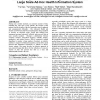Free Online Productivity Tools
i2Speak
i2Symbol
i2OCR
iTex2Img
iWeb2Print
iWeb2Shot
i2Type
iPdf2Split
iPdf2Merge
i2Bopomofo
i2Arabic
i2Style
i2Image
i2PDF
iLatex2Rtf
Sci2ools
102
click to vote
MOBISYS
2007
ACM
2007
ACM
Participatory user centered design techniques for a large scale ad-hoc health information system
During mass casualty incidents, an enormous amount of data, including the vital signs of the patients, the location of the patients, and the location of the first responders must be gathered and communicated efficiently. The Advanced Health and Disaster Aid Network (AID-N) used participatory design methods to develop an electronic triage system that changed how emergency personnel interacted, collected, and processed data at mass casualty incidents. Through a collaboration between computer scientists, biomedical engineers, usability analysts, paramedics, and medical doctors, AID-N constructed scalable algorithms to monitor a large numbers of patients, an intuitive interface to support overwhelmed responders, and an ad-hoc mesh network that maintained connectivity to patients in ad-hoc, chaotic settings. This paper describes an iterative approach to user-centered design that allows for the collection of a massive amount of data and presents this data in a clear and understandable forma...
Ad-hoc Mesh Network | Mass Casualty Incidents | MOBISYS 2007 | Overwhelmed Responders | Wireless Networks |
| Added | 24 Dec 2009 |
| Updated | 24 Dec 2009 |
| Type | Conference |
| Year | 2007 |
| Where | MOBISYS |
| Authors | Tia Gao, Tammara Massey, Majid Sarrafzadeh, Leo Selavo, Matt Welsh |
Comments (0)

